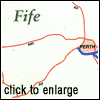|
Dunfermline
Dunfermline was one of the most important ancient
Scottish capitals until the time of James VI of Scotland (James I of England) and
the Union of the Crowns in 1603. Lying 2 miles (3km) inland from the Firth of Forth,
it is today a main focus of commercial activity for south-west Fife, situated as
it is near the M90 motorway. Its narrow town-centre streets are usually busy, mainly
with 'Fifers' going about their business, a fairly typical lowland market town but
with a particularly rich heritage.
 Most of the important areas of Dunfermline can be explored
by foot and there is ample sign-posted car-parking near the abbey and its historic
precincts. Approaching the town by car from the south under the high railway viaducts,
your eye is drawn to the central elevation on which sits Dunfermline Palace and Abbey.
The words 'King Robert the Bruce' can be seen like an early advertising hoarding,
carved in huge stone letters surrounding the balustrade of the nineteenth century
parish church which nestles alongside the abbey. Most of the important areas of Dunfermline can be explored
by foot and there is ample sign-posted car-parking near the abbey and its historic
precincts. Approaching the town by car from the south under the high railway viaducts,
your eye is drawn to the central elevation on which sits Dunfermline Palace and Abbey.
The words 'King Robert the Bruce' can be seen like an early advertising hoarding,
carved in huge stone letters surrounding the balustrade of the nineteenth century
parish church which nestles alongside the abbey.
The largely ruined Dunfermline Abbey and Palace was
a great Benedictine house built in the time of King Malcolm Canmore (1005-1034) by
his wife, Margaret. Queen Margaret was instrumental in the reformation of the nation
from Celtic religious practices to Catholic. The present site is a loose arrangement
bringing together buildings of several eras, the ruined monastery and palace with
their romantic aura standing next to a much restored and more austere nineteenth
century church.
 Enthusiastic and well-informed locals provide guided tours.
In the church choir, under the pulpit beneath a great brass plaque, the bones of
Robert the Bruce are buried. In 1818, whilst preparing the foundations for the present
church, a stone coffin was discovered by workmen who found the skeleton wrapped in
lead and covered with gold cloth. Its breastbone had been sawn indicating that the
heart, in accordance with Bruce's instructions, had been removed. He decreed that
his heart be carried to the Holy Land to atone for his murderous accession to the
throne. Sir James Douglas was charged with the task but was killed in Spain doing
battle with the Moors. Fortunately the heart was retrieved and returned to Scotland
where it is now buried at Melrose Abbey in the Borders while his bones remain in
Dunfermline. Enthusiastic and well-informed locals provide guided tours.
In the church choir, under the pulpit beneath a great brass plaque, the bones of
Robert the Bruce are buried. In 1818, whilst preparing the foundations for the present
church, a stone coffin was discovered by workmen who found the skeleton wrapped in
lead and covered with gold cloth. Its breastbone had been sawn indicating that the
heart, in accordance with Bruce's instructions, had been removed. He decreed that
his heart be carried to the Holy Land to atone for his murderous accession to the
throne. Sir James Douglas was charged with the task but was killed in Spain doing
battle with the Moors. Fortunately the heart was retrieved and returned to Scotland
where it is now buried at Melrose Abbey in the Borders while his bones remain in
Dunfermline.
For lovers of Robert Burns and his poetry, the Murison
Burns Collection is found in Dunfermline's Central Library in Abbots Street. A collection
of books, pamphlets, prints, portraits and commemorative bric-a-brac relating to
the life and works of the 'Great Bard' is found there.
In Moodie Street, an old weaver's cottage was, in
1835, the birthplace of the great industrialist, Andrew Carnegie. This weaver's son
immigrated to America to become, through the steel industry, one of the world's richest
and most benevolent men. In vastly generous but perceptive donations, he gave away
350 million dollars for the benefit of mankind doing great service to many branches
of academia and the preservation of history but at the same time some damage to the
fable that the Scots were mean.
 One of his local purchases was Pittencrieff House Museum situated
in Pittencrieff Park, locally known as the 'Glee'. The house dates back to 1610 and
was purchased along with the marvellous open parkland by Carnegie in 1902, to display
certain items of local history, costumes and art. One of his local purchases was Pittencrieff House Museum situated
in Pittencrieff Park, locally known as the 'Glee'. The house dates back to 1610 and
was purchased along with the marvellous open parkland by Carnegie in 1902, to display
certain items of local history, costumes and art.
When Andrew Carnegie was a small boy, he was forbidden
entrance to the then privately-owned estate. He never forgot this, and on his return
from America bought the estate and gave it to the people of Dunfermline 'so that
no child should ever feel locked out'. His life is amply illustrated at the Carnegie
Museum found opposite his cottage birthplace just beyond the park. The family lived
upstairs while the room below contained his father's weaver's workshop.
|



